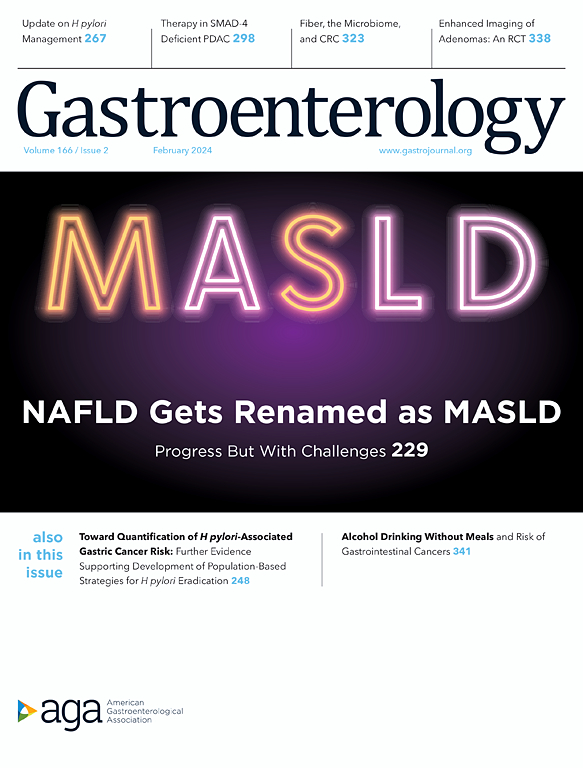aav介导的Sox4沉默导致Alagille综合征小鼠模型肝脏表型的长期改善
IF 25.7
1区 医学
Q1 GASTROENTEROLOGY & HEPATOLOGY
引用次数: 0
摘要
背景,在患有Alagille综合征(ALGS)的患者中,胆管缺乏通常导致严重的胆汁淤积表型,肝移植仍然是唯一确定的治疗方法。目前还没有fda批准的基于机制的策略来促进ALGS或其他胆管缺乏疾病的胆道发育。我们的目标是确定一个治疗靶点来解决这一未满足的需求。方法采用缺乏一个Jag1拷贝的ALGS小鼠模型,同时或不同时条件缺失一个或两个Sox9拷贝。Sox4水平通过基因或腺相关病毒8 (AAV8)载体驱动Sox4沉默序列而降低。进行肝脏组织学、胆道树墨水注射、血清化学、RNAscope(小鼠和人肝脏)、小鼠肝脏单细胞rna测序(scRNA-Seq)和已发表的人肝脏大体积RNA-Seq再分析。结果有条件地去除小鼠肝脏中的一个Sox4拷贝,以sox9依赖的方式显著改善ALGS肝脏表型。观察到出生后早期jag1杂合小鼠肝脏和ALGS患者肝脏中Sox4/ Sox4表达升高。scRNA-Seq显示,在jag1杂合肝脏中出现了一个中间的肝胆簇,共表达Sox4和Sox9。aav8介导的Sox4敲低,普遍存在或由肝细胞特异性TBG启动子驱动,导致出生后第1天注射后ALGS肝脏表型的长期改善(P1)。在p15 -肝坏死出现后注射AAV8导致一些转导细胞进入胆管并改善表型。结论临床前研究为出生后aav介导的TBG+细胞中Sox4的下调作为ALGS肝病的治疗方法提供了原理证明。本文章由计算机程序翻译,如有差异,请以英文原文为准。

AAV-mediated silencing of Sox4 leads to long-term amelioration of liver phenotypes in mouse models of Alagille syndrome
BACKGROUND & AIMS
In patients with Alagille syndrome (ALGS), bile duct paucity often leads to severe cholestatic phenotypes for which liver transplantation remains the only definitive treatment. No FDA-approved mechanism-based strategies exist to enhance biliary development in ALGS or other diseases with bile duct paucity. We aimed to identify a therapeutic target to address this unmet need.METHODS
Preclinical ALGS mouse models lacking one copy of Jag1 with or without conditional deletion of one or both copies of Sox9 were used. Sox4 levels were reduced genetically or with adeno-associated virus 8 (AAV8) vectors driving a Sox4-silencing sequence. Liver histology, biliary tree ink injection, serum chemistry, RNAscope (on mouse and human livers), mouse liver single-cell RNA-sequencing (scRNA-Seq), and reanalysis of published human liver bulk RNA-Seq were performed.RESULTS
Conditional removal of one copy of Sox4 in mouse liver significantly improved the ALGS liver phenotypes in a Sox9-dependent manner. An increase in Sox4/SOX4 expression in early postnatal Jag1-heterozygous mouse livers and ALGS patient livers was observed. scRNA-Seq revealed the appearance of an intermediate hepatobiliary cluster co-expressing Sox4 and Sox9 in Jag1-heterozygous livers. AAV8-mediated Sox4 knockdown, ubiquitously or driven by the hepatocyte-specific TBG promoter, led to long-term improvement of ALGS liver phenotypes upon injection at postnatal day 1 (P1). AAV8 injection at P15—after the appearance of liver necrosis—led to the incorporation of some transduced cells into bile ducts and phenotypic improvement.CONCLUSIONS
Preclinical studies provide proof of principle for postnatal AAV-mediated Sox4 knockdown in TBG+ cells as a therapeutic approach for ALGS liver disease.求助全文
通过发布文献求助,成功后即可免费获取论文全文。
去求助
来源期刊

Gastroenterology
医学-胃肠肝病学
CiteScore
45.60
自引率
2.40%
发文量
4366
审稿时长
26 days
期刊介绍:
Gastroenterology is the most prominent journal in the field of gastrointestinal disease. It is the flagship journal of the American Gastroenterological Association and delivers authoritative coverage of clinical, translational, and basic studies of all aspects of the digestive system, including the liver and pancreas, as well as nutrition.
Some regular features of Gastroenterology include original research studies by leading authorities, comprehensive reviews and perspectives on important topics in adult and pediatric gastroenterology and hepatology. The journal also includes features such as editorials, correspondence, and commentaries, as well as special sections like "Mentoring, Education and Training Corner," "Diversity, Equity and Inclusion in GI," "Gastro Digest," "Gastro Curbside Consult," and "Gastro Grand Rounds."
Gastroenterology also provides digital media materials such as videos and "GI Rapid Reel" animations. It is abstracted and indexed in various databases including Scopus, Biological Abstracts, Current Contents, Embase, Nutrition Abstracts, Chemical Abstracts, Current Awareness in Biological Sciences, PubMed/Medline, and the Science Citation Index.
 求助内容:
求助内容: 应助结果提醒方式:
应助结果提醒方式:


